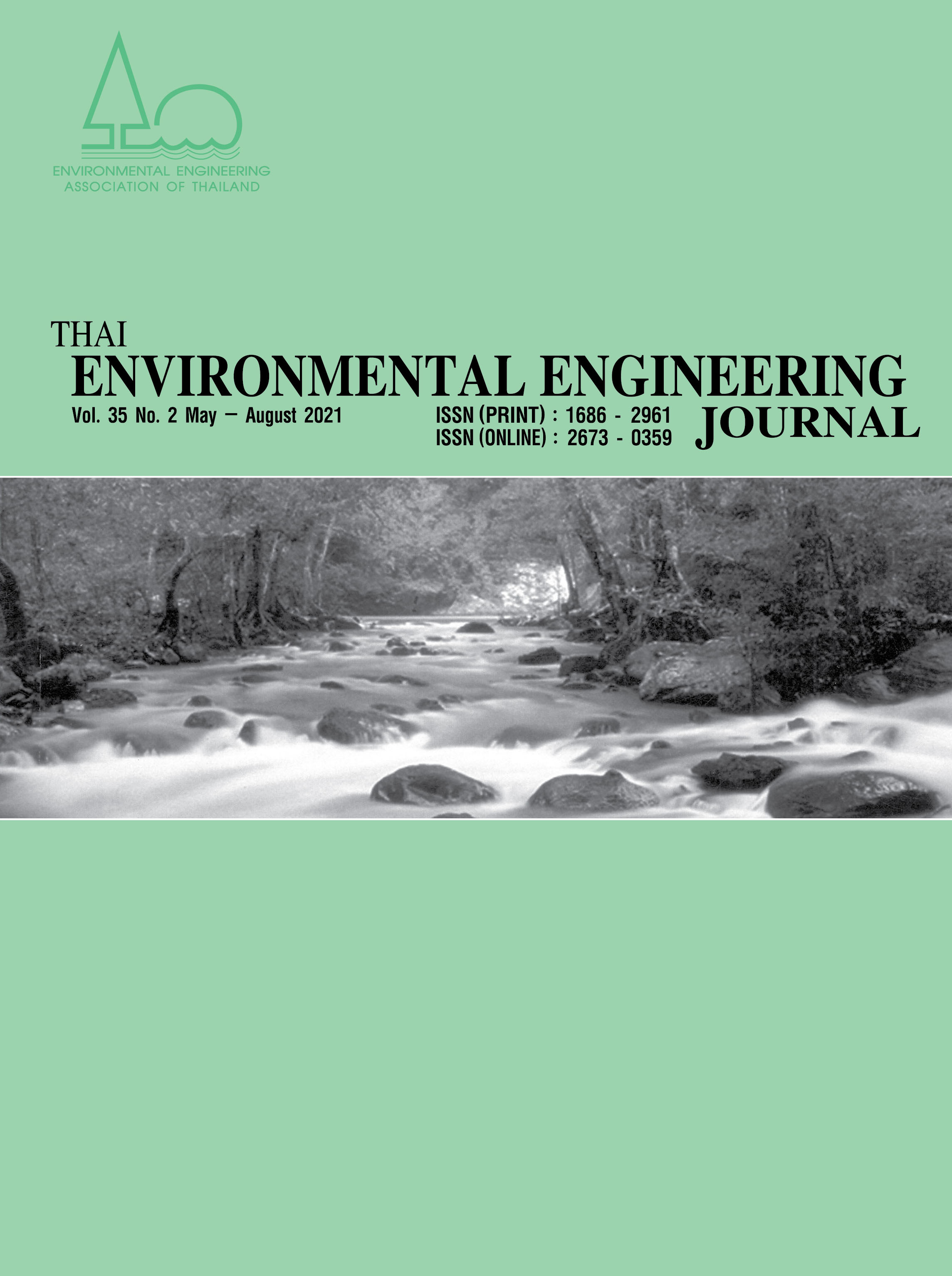Development of Scale to Predict Effect of Three Alkali Activated Solution on Compressive Strength and Microstructure of Geopolymer Based Fly Ash
Main Article Content
Abstract
This research aimed to develop a scale to predict the effect of alkali-activated solution on compressive strength and microstructure of geopolymer based fly ash. The starting material for geopolymer synthesis was fly ash obtained from Mea Moh electricity thermal power plant. Sodium hydroxide 10M, sodium silicate solution and calcium hydroxide solution were used as alkali-activated solutions for geopolymer. The proportions of alkali -activated in the geopolymer mixture were calculated by simplex lattice design. The compressive strength of geopolymer was investigated at the age of 7, 14 and 28 days. The surface area of the geopolymer samples was characterized by OM technic. The results of compressive strength were input into a Minitab program to construct the scale for predicting and plotting the mixture contour. The results showed that the compressive strength of geopolymer had a range between 0 and 200 ksc. Using sodium hydroxide and sodium silicate solution to be alkali activated solution for geopolymer provided the highest compressive strength. It is worth mentioning that sodium hydroxide is a strong alkali hydroxide which dissolved Si and Al from fly ash; additionally, geopolymer could also be formed from free silica in the sodium silicate solution. On the other hand, geopolymer synthesized with calcium hydroxide solution presented the lowest compressive strength due to the solution being a less strong alkaline to dissolve Si and Al from fly ash. The equation for predicting the compressive strength in ksc of geopolymer with three alkali-activated solutions is Y = 202.49NH-3.63NS+43.20CH+461.24(NH*NS)-61.81(NH*CH)+559.15(NS*CH)+45.98(NH*NS*CH) where Y is compressive strength of geopolymer in ksc.
Article Details
References
Davidovits, J., 2008, Geopolymer Chemistry and Applications (2nd ed.), Saint-Quentin, FR: Geopolymer Institute, France, 585 p.
Somna, K., Jaturapitakkul, C., Kajitvichyanukul, P., Chindaprasirt, P. 2011, NaOH-activated ground fly ash geopolymer cured at ambient temperature, Fuel, 90: 2118-2124.
Sun, W., Zhang, Y.S., Lin, W. and Liu, Z.Y. 2004. In Situ Monitoring of the Hydration Process of K-PS Geopolymer Cement with ESEM, Cement and Concrete Research, 34: 935-940.
Nuaklong P., Wongsa A., Sata V., Boonserm K., Sanjayan J., Chindaprasirt P., 2019, Properties of high-Calcium and low-calcium fly ash combination geopolymer mortar containing recycled aggregate, Heliyon, 5(9), September 2019, e02513.
Ayi D.Hounsi, GisèleLecomte-Nana, GnandéDjétéli, PhilippeBlanchart, Dovenam Alowanou, PaliKpeloua, KossiNapo, GadoTchangbédji, MirelaPraisler, 2014, How does Na, K alkali metal concentration change the early age structural characteristic of kaolin-based geopolymers, Ceramics International, 40: 8953-8962.
Barbosa, V.F.F., Kenneth, J.D. and MacKenzie, 2003, Thermal Behaviour of Inorganic Geopolymers and Composites Derived from Sodium Polysialate, Materials Research Bulletin, 38: 319-331.
Karim, MR, Hossain, MM, Khan, MNN, Zain, MFM, Jamil, M, Lai, FC. 2014. On the utilization of pozzolanic wastes as an alternative resource of cement. Materials, 7: 7809-7827.
Mustafa Al Bakri, A. M Kamarudin, H. Bnhussain, M. Khairul Nizar, I. Rafiza A. R and Zarina, Y. 2011, Microstructure of different NaOH molarity of fly ash base green polymeric cement, Journal of Engineering and Technology Research, 3(2): 44-49.
Temuujin, J., Van Riessen, A., Williams, R., 2009, Influence of calcium compounds on the mechanical properties of fly ash geopolymer pastes, Journal of Hazardous Materials, 167: 82-88.
Yip C.K., Lukey G.C., Deventer J.S.J., 2005, The Coexistence of Geopolymeric and Calcium Silicate Hydrate at The Early Stage of Alkaline Activation, Cement and Concrete Research, 35: 1688-1697.
Somna, K., Bumrongjaroen, W., Effect of external and internal Calcium in Fly Ash on Geopolymer Formation, 2011, Developments in Strategic Materials and Computational Design II: Ceramic Engineering and Science Proceedings, 32: 3-16.
ASTM C618-08a, “Standard Specification for Coal Fly Ash and Raw or Calcined Natural Pozzolan for Use Mineral Admixture in Portland Cement Concrete.” Annual Book ASTM Standard. Pennsylvania (USA), ASTM International, 2010. 4 p.
Chindaprasirt, P., Jaturapitakkul, C. and Sinsiri, T. 2007, Effect of Fly Ash Fineness on Microstructure of Blended Cement Paste”, Construction and Building Materials, 21: 1534-1541.
Rattanasak U and Chindaprasirt, P. 2009, Influence of NaOH solution on the synthesis of fly ash geopolymer, Minerals Engineering, 22(12): 1073-1078.


